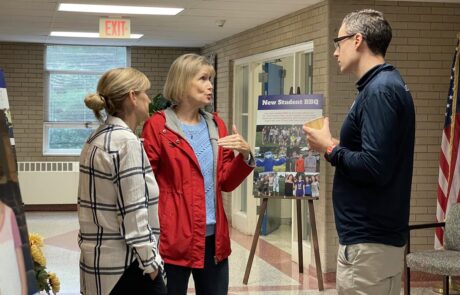
Father Robert Spitzer, president of the Magis Center, addresses Catholic high school educators during the Teaching & Learning Conference on “Faith and Science” at St. Paul Catholic High School in Bristol.
Story and Photos by Shelley Wolf
Catholic educators have the power to stem the flow of young people leaving the Catholic faith – by addressing students’ mistaken notion that their belief in science means they have to give up their faith in God. Instead, science and reason can be shown to support the faith.
So says Father Robert Spitzer, a noted scholar, who spoke to Catholic educators recently at the Teaching & Learning Conference on the topic of “Faith and Science” at St. Paul Catholic High School in Bristol. Father Spitzer is president of the Magis Center and the featured theologian and philosopher on EWTN’s TV show “Father Spitzer’s Universe.”
The two-day conference was aimed at Catholic elementary school teachers the first day, and high school teachers on the second. Father Spitzer’s talk was intended to bolster the teachers’ own faith.
In addition to listening to the presentation, educators spent the afternoon in workshops, where they learned practical, grade-appropriate lessons for teaching students about Eucharistic miracles, the wonders of nature, and the expansion of the universe – all as evidence pointing to an intelligent creator.
“The majority of students who leave will leave for one major reason: They think that faith and science are contradictory,” Father Spitzer says, referring to a Pew study conducted for the Center for Applied Research in the Apostolate at Georgetown University that revealed young Catholics abandon their faith at a median age of 13.
Their thinking goes, “Science is true. Therefore, faith must be false,” Father Spitzer explains.
“If you don’t address this question, we’re probably going to lose 42 percent when they go to college. You’re going to lose another 20 percent when they’re young adults. So there’s going to be 62 percent just zinging right off the cliff for no apparent reason – because the evidence actually favors God, not goes against him,” Father Spitzer insists.
Teachers, he says, can give students “good, hard scientific facts that will help them to stay in the faith and that actually give credible evidence for the faith.”
For instance, not all scientists are atheists. The landscape has changed in the past 20 years, revealing a growing belief among scientists in an intelligent creator. One Pew study shows that 51 percent of scientists believe in a higher transcendent power. Among young scientists, 66 percent are inclined to believe in God. “Look at where the trend line is – it’s increasing in faith,” Father Spitzer points out.
Additionally, National Institutes of Health research shows 73 to 74 percent of physicians believe in miracles past and present. “Because they have seen miracles,” Father Spitzer says.
Then there are near-death experiences. In 2022, the New York Academy of Sciences published a peer-reviewed study of other peer-reviewed studies. “And they came up saying, yeah, there’s a real credible possibility that when you die, it’s not all over. When you die, your consciousness may well survive your bodily death,” Father Spitzer reports. “Whoa, they better have some reason for saying this because it’s not a typical scientific or medical statement.”
The priest and scholar also addressed studies on the Shroud of Turin. “Everything points to it being the burial cloth of Jesus,” he says.
The blood evidence on the cloth precisely parallels the Gospel accounts of Jesus’ unique crucifixion, shows an AB blood type in stains soaked into the cloth, and there’s an image lying on the surface of the cloth that can only be explained by “a huge burst of particle radiation,” he says. In other words, Father Spitzer translates, “the Resurrection.”
“It’s almost as if Christ’s body,” Father Spitzer concludes, “is becoming a spiritual body and leaving the imprint of itself on the cloth.”



